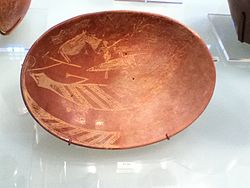Early Dynastic Period (Egypt)
Early Dynastic Period of Egypt tȝwy | |||||||||||
|---|---|---|---|---|---|---|---|---|---|---|---|
| c. 3150 BC – c. 2686 BC | |||||||||||
 | |||||||||||
| Capital | Memphis | ||||||||||
| Common languages | Ancient Egyptian | ||||||||||
| Religion | Ancient Egyptian religion | ||||||||||
| Government | Monarchy | ||||||||||
| Pharaoh | |||||||||||
• c. 3100 BC | Narmer (first) | ||||||||||
• c. 2690 BC | Khasekhemwy (last) | ||||||||||
| History | |||||||||||
• Established | c. 3150 BC | ||||||||||
• Disestablished | c. 2686 BC | ||||||||||
| |||||||||||
| Today part of | |||||||||||

| ||
| tȝwy 'Two Lands' in hieroglyphs |
|---|
The Early Dynastic Period of Egypt began when Lower and Upper Egypt were joined together as one country in about 3100 BC. This was called the Two Lands. The First and Second Dynasties ruled during this time. It ended in about 2686 BC, at the beginning of the Old Kingdom.[1]
The capital city of the Two Lands was moved from Thinis to Memphis. The united Egypt was ruled by an Egyptian god-king. The main features of ancient Egyptian civilization, such as art, architecture and religion, took shape during this time.
Before the Early Dynastic Period, Egypt was settled with small, separate villages. The rulers were able to set up a government system across the whole country, run by local royal governors. Government buildings were usually open-air temples made of wood or sandstone. Writing, in hieroglyphs began to be used just before this period. Little is known about the spoken language.
Cultural development[change | change source]
By about 3600 BC, neolithic Egyptian societies on the River Nile were growing crops and farming with animals.[2] Shortly after 3600 BC Egyptian society began to grow and advance rapidly.[3] They made pottery in a new style and began using copper.[3] The Egyptians began using sun-dried bricks for building. They also started using the arch, and recessed walls for decorative effect.[3]
The societies and towns on the upper Nile River, or Upper Egypt began to join together. This was also happening in the Nile Delta, or Lower Egypt.[3] There were often wars between Upper and Lower Egypt.[3] During his rule in Upper Egypt, King Narmer defeated his enemies on the Delta. He joined the Kingdom of Upper and Lower Egypt together under his rule.[4] Narmer is shown in pictures wearing the double crown, called the Pschent, with the lotus flower of Upper Egypt and the papyrus reed of Lower Egypt. These symbols of a united Egypt were used by all future rulers. In mythology, the falcon-god, Horus of Lower Egypt, won a battle over the god Seth, of Upper Egypt.[5] This helped start the idea that Egyptian kings were gods and divine, which lasted for 3,000 years. It was the basis of Egypt's government.[6] The unification of societies of the Nile has also been linked to the drying of the Sahara.
Rich people began to have more complex funeral practices. The Egyptians began building mastabas which became models for later buildings, such as the Old Kingdom's Step pyramid. The growing of cereal crops and the use of central control to organize farm workers helped the success of the state for the next 800 years.
It seems certain that Egypt was unified culturally and economically long before its first king ruled from the city of Memphis. Political unification was a slow process, taking place over a century or so. Local areas started trading networks and governments were able to organize farm workers on a large scale. Divine kingship gained importance as the cults of gods like Horus, Seth and Neith spread across the country.[7]
The Egyptian writing system was further developed. At first Egyptian writing was a few symbols showing amounts of various items. By the end of the third dynasty it had been grown to more than 200 symbols, both phonograms and ideograms.[6]
First Pharaoh[change | change source]
Manetho, an Egyptian historian, said almost three thousand years later that Menes was the first king of the Two Lands. Menes is probably Narmer, the earliest recorded king of the First Dynasty[3] Narmer's name is on the king lists of Den and Qa'a.[8] The first dynasty kings saw Narmer as an important founding figure. Narmer is also the earliest king linked to the symbols of power over the two lands. The Narmer palette, a special cosmetic palette designed for ritual use, shows him wearing the Pschent, the double crown of Upper and Lower Egypt. Another theory is that Narmer was the last king of the Protodynastic Period[5] and that Menes was Hor-Aha.
References[change | change source]
- ↑ Shaw, Ian, ed. (2000). The Oxford History of Ancient Egypt. Oxford University Press. p. 479. ISBN 0-19-815034-2.
- ↑ Carl Roebuck, The World of Ancient Times (Charles Scribner's Sons Publishing: New York, 1966) p. 51.
- ↑ 3.0 3.1 3.2 3.3 3.4 3.5 Carl Roebuck, The World of Ancient Times (Charles Scribner's Sons: New York, 1966) p. 52-53.
- ↑ Carl Roebuck, The World of Ancient Times (Charles Scribner's Sons Publishers: New York, 1966), p. 53.
- ↑ 5.0 5.1 Carl Roebuck, The World of Ancient Times, p. 53.
- ↑ 6.0 6.1 Kinnaer, Jacques. "Early Dynastic Period" (PDF). The Ancient Egypt Site. Retrieved 4 April 2012.
- ↑ The Penguin Historical Atlas of Ancient Egypt pg 22-23 (1997) By Bill Manley
- ↑ Qa'a and Merneith lists http://xoomer.virgilio.it/francescoraf/hesyra/Egyptgallery03.html
Further reading[change | change source]
- Shaw, Ian (2003). The Oxford History of Ancient Egypt. UK: Oxford University Press. ISBN 978-0-19-280458-7.
- Wilkinson, Toby (2001). Early Dynastic Egypt: Strategies, Society and Security. New York: Routledge. ISBN 0-415-26011-6.
- Wengrow, David (2006). The Archaeology of Early Egypt: Social Transformations in North-East Africa, c. 10,000 to 2,650 BC. New York: Cambridge University Press. ISBN 0-521-83586-0.

